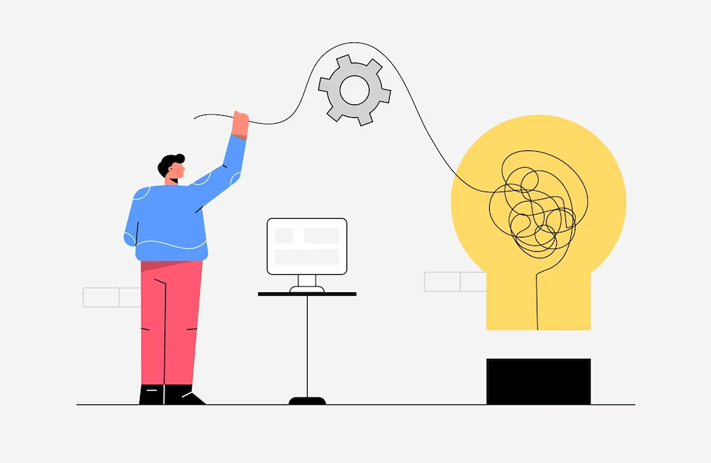
Click the button to start reading
Tackling Workplace Challenges: How to Improve Your Problem-Solving Skills
Picture this: you’re in the middle of your workday, and suddenly, a problem arises. Maybe it’s a miscommunication between team members, a tight deadline that’s getting closer, or an unhappy customer you need to appease.
Sounds familiar, doesn’t it?
The thing is, facing challenges at work is pretty much inevitable. But what sets successful professionals apart is their knack for tackling these issues head-on with a problem-solving mindset.
You see, being a great problem solver is a game-changer in any work environment. It helps us navigate through obstacles, come up with creative solutions, and turn potential setbacks into opportunities for growth.
In this article, we will dive into some common workplace problems and explore real-life examples of problem-solving scenarios.
We’ll also share practical solutions and strategies that you can use to tackle these challenges, ultimately empowering you to become a more effective problem solver and team player.

Common Workplace Problems Businesses Experience
Before we dive into the nitty-gritty of problem-solving scenarios, let’s take a quick look at some of the most common workplace problems that almost every professional encounters at some point in their career.
By understanding these challenges, we’ll be better equipped to recognize and address them effectively.
Communication breakdowns
Miscommunications and misunderstandings can happen to the best of us. With team members working together, sometimes remotely or across different time zones, it’s not surprising that communication breakdowns can occur. These issues can lead to confusion, missed deadlines, and even strained relationships within the team if left unaddressed.
Some examples of communication breakdowns include:
- Unclear instructions
- Lack of updates on project progress
- Messages lost in a sea of emails
Fostering open communication channels and utilizing collaboration tools can help teams stay connected and informed.
Conflicting priorities and resource allocation
With limited resources and multiple projects competing for attention, it can be challenging to determine which tasks should take precedence. Juggling conflicting priorities and allocating resources efficiently is a common workplace problem that can result in decreased productivity and increased stress if not managed properly.
For example, two high-priority projects might be scheduled simultaneously, leaving team members stretched thin and struggling to meet deadlines. Developing a clear project prioritization framework and regularly reviewing priorities can help teams stay focused and manage their resources effectively.
Employee performance issues
It’s not unusual for team members to face performance-related challenges occasionally. Employee performance issues can affect team productivity and morale, whether it’s due to a lack of skills, motivation, or other factors. Identifying and addressing these concerns early on is crucial for maintaining a high-performing and engaged team.
For instance, employees may struggle to keep up with their workload due to a skills gap or personal issues. Providing coaching, training, and support can help employees overcome performance challenges and contribute positively to the team’s success.
Customer satisfaction challenges
Meeting customer expectations and delivering exceptional service are goals for most organizations. However, addressing customer satisfaction challenges can be tricky, especially when dealing with diverse customer needs, tight deadlines, or limited resources.
Ensuring a customer-centric approach to problem-solving can help overcome these obstacles and keep your customers happy.
For example, a product might not meet customer expectations, resulting in negative feedback and returns. By actively listening to customer concerns, involving them in the solution process, and implementing improvements, organizations can turn customer dissatisfaction into opportunities for growth and enhanced customer loyalty.
Adapting to change
Change is inevitable in the modern workplace, whether due to new technology, evolving market conditions, or organizational restructuring. Adapting to change can be difficult for some team members, leading to resistance or fear of the unknown.
Embracing a flexible mindset and developing strategies to cope with change is essential for maintaining a productive and resilient work environment.
For instance, a company might introduce new software that requires employees to learn new skills, causing anxiety and frustration. By providing training, resources, and support, leaders can help team members adapt to change more effectively and even become champions of new initiatives.

How to Identify Workplace Problems
A problem-free workplace doesn’t exist.
Even if you run a well-oiled machine with many happy employees, it’s still a good idea to proactively search for any problems.
The earlier you can get ahead of issues, the easier it will be to put things right and avoid any breakdowns in productivity. Here’s how you can go about that:
Recognizing the Signs of Potential Issues
Before diving into problem-solving strategies, it’s essential first to identify the workplace problems that need attention.
Look out for signs that could indicate potential issues, such as decreased productivity and efficiency, increased employee turnover or dissatisfaction, frequent miscommunications, and conflicts, or declining customer satisfaction and recurring complaints. These red flags might signal underlying problems that require your attention and resolution.
Proactive Problem Identification Strategies
To stay ahead of potential issues, it’s crucial to adopt a proactive approach to problem identification. Open communication channels with your team members and encourage them to share their concerns, ideas, and feedback.
Regular performance reviews and feedback sessions can also help identify areas for improvement or potential problems before they escalate.
Fostering a culture of transparency and trust within the organization makes it easier for employees to voice their concerns without fear of retribution. Additionally, utilizing data-driven analysis and performance metrics can help you spot trends or anomalies that may indicate underlying problems.
Seeking Input from Various Sources
When identifying workplace problems, gathering input from various sources is crucial to ensure you’re getting a comprehensive and accurate picture of the situation. Employee surveys and suggestion boxes can provide valuable insights into potential issues.
At the same time, team meetings and brainstorming sessions can stimulate open discussions and creative problem-solving.
Cross-departmental collaboration is another effective way to identify potential problems, enabling different teams to share their perspectives and experiences. In some cases, it might be helpful to seek external expert consultations or benchmark against industry standards to gain a broader understanding of potential issues and identify best practices for resolving them.

Problem-Solving Scenario Examples and Solutions
Let’s dive into some real-life problem-solving scenarios, exploring the challenges and their practical solutions. We’ll discuss communication issues, conflicting priorities, employee performance, customer satisfaction, and managing change.
Remember, every situation is unique; these examples are just a starting point to inspire your problem-solving process.
Scenario 1: Resolving communication issues within a team
- Identifying the root causes: Let’s say your team has been missing deadlines and experiencing confusion due to poor communication. The first step is identifying the root causes, such as ineffective communication tools, unclear instructions, or a lack of regular updates.
- Implementing effective communication strategies: Implement strategies to improve communication. For example, consider adopting collaboration tools like Slack or Microsoft Teams to streamline communication, establish clear channels for updates, and create guidelines for concise and transparent instructions.
- Encouraging a culture of openness and feedback: Cultivate a team culture that values openness and feedback. Encourage team members to voice concerns, ask questions, and share ideas. Regularly hold check-ins and retrospectives to discuss communication challenges and opportunities for improvement.
Scenario 2: Balancing conflicting priorities and resource constraints
- Evaluating project requirements and resources: In this scenario, you’re juggling two high-priority projects with limited resources. Start by evaluating each project’s requirements, resources, and potential impact on the organization.
- Prioritization techniques and delegation: Use prioritization techniques like the Eisenhower Matrix or MoSCoW method to rank tasks and allocate resources accordingly. Delegate tasks efficiently by matching team members’ skills and expertise with project requirements.
- Continuous monitoring and adjustment: Regularly monitor project progress and adjust priorities and resources as needed. Keep stakeholders informed about changes and maintain open lines of communication to ensure alignment and avoid surprises.
Scenario 3: Addressing employee performance concerns
- Identifying performance gaps: When an employee’s performance is below expectations, identify the specific areas that need improvement. Is it a skills gap, lack of motivation, or external factors like personal issues?
- Providing constructive feedback and support: Provide clear, constructive feedback to the employee, highlighting areas for improvement and offering support, such as training, coaching, or mentorship.
- Developing performance improvement plans: Collaborate with the employee to develop a performance improvement plan, outlining specific goals, timelines, and resources. Regularly review progress and adjust the plan as needed.
Scenario 4: Improving customer satisfaction
- Analyzing customer feedback and pain points: In this scenario, customers are dissatisfied with a product, resulting in negative feedback and returns. Analyze customer feedback to identify common pain points and areas for improvement.
- Implementing customer-centric solutions: Work with your team to develop and implement solutions that address customer concerns, such as enhancing product features or improving customer support.
- Monitoring progress and iterating for success: Regularly monitor customer satisfaction levels and gather feedback to assess the effectiveness of your solutions. Iterate and improve as needed to ensure continuous progress toward higher customer satisfaction.
Scenario 5: Managing change and uncertainty
- Assessing the impact of change on the organization: When faced with change, such as the introduction of new software, assess the potential impact on the organization, including the benefits, challenges, and required resources.
- Developing a change management plan: Create a comprehensive change management plan that includes communication strategies, training, and support resources to help team members adapt to the change.
- Fostering resilience and adaptability among team members: Encourage a culture of resilience and adaptability by providing ongoing support, celebrating small wins, and recognizing the efforts of team members who embrace and champion the change.
Scenario 6: Navigating team conflicts
- Identifying the sources of conflict: When conflicts arise within a team, it’s crucial to identify the underlying issues, such as personality clashes, competing interests, or poor communication.
- Facilitating open discussions and mediation: Arrange a meeting with the involved parties to discuss the conflict openly and objectively. Consider using a neutral third party to mediate the conversation, ensuring everyone’s perspective is heard and understood.
- Developing and implementing conflict resolution strategies: Work together to develop strategies for resolving the conflict, such as setting clear expectations, improving communication, or redefining roles and responsibilities. Monitor progress and adjust strategies as needed to ensure long-term resolution.
Scenario 7: Overcoming deadline pressure and time management challenges
- Assessing project progress and priorities: If a team is struggling to meet deadlines, assess project progress and review priorities. Identify tasks that are behind schedule, and determine if any can be reprioritized or delegated.
- Implementing time management techniques: Encourage the team to adopt effective time management techniques, such as the Pomodoro Technique or time blocking, to maximize productivity and stay focused on tasks.
- Adjusting project scope and resources as needed: In some cases, it may be necessary to adjust the project scope or allocate additional resources to ensure successful completion. Communicate any changes to stakeholders and maintain transparency throughout the process.
Scenario 8: Tackling low employee morale and engagement
- Identifying the causes of low morale: When faced with low employee morale, it’s essential to identify the contributing factors, such as lack of recognition, insufficient growth opportunities, or unrealistic expectations.
- Implementing targeted initiatives to boost morale: Develop and implement initiatives to address these factors, such as offering regular feedback and recognition, providing professional development opportunities, or reassessing workload and expectations.
- Monitoring and adjusting efforts to improve engagement: Regularly monitor employee morale and engagement through surveys or informal conversations. Adjust your initiatives to ensure continuous improvement and maintain a positive work environment.

Developing Problem-Solving Skills in the Workplace
As we’ve seen, problem-solving is a crucial skill for navigating the myriad challenges that can arise in the workplace. To become effective problem solvers, you must develop hard and soft skills that will allow you to tackle issues head-on and find the best solutions.
Let’s dive into these skills and discuss how to cultivate them in the workplace.
Soft Skills
Soft skills are non-technical, interpersonal abilities that help you interact effectively with others, navigate social situations, and perform well in the workplace. They are often referred to as “people skills” or “emotional intelligence” because they involve understanding and managing emotions and building relationships with colleagues, clients, and stakeholders.
Soft skills are typically learned through life experiences and personal development rather than formal education or training.
Examples of soft skills include:
- Critical thinking: Critical thinking is the ability to analyze a situation objectively, considering all relevant information before making a decision. To develop this skill, practice asking open-ended questions, challenging assumptions, and considering multiple perspectives when approaching a problem.
- Effective communication: Strong communication skills are vital for problem-solving, as they enable you to express your ideas clearly and listen actively to others. To improve your communication skills, focus on being concise, empathetic, and open to feedback. Remember that nonverbal communication, such as body language and tone, can be just as important as the words you choose.
- Collaboration and teamwork: Problem-solving often requires collaboration, as multiple minds can bring diverse perspectives and fresh ideas to the table. Foster a sense of teamwork by being open to others’ input, sharing knowledge, and recognizing the contributions of your colleagues.
- Emotional intelligence: The ability to recognize and manage your emotions, as well as empathize with others, can significantly impact your problem-solving abilities. To cultivate emotional intelligence, practice self-awareness, self-regulation, and empathy when dealing with challenges or conflicts.
- Adaptability and resilience: In a constantly changing work environment, the ability to adapt and bounce back from setbacks is essential. Develop your adaptability and resilience by embracing change, learning from failure, and maintaining a growth mindset.
Hard Skills
Hard skills, on the other hand, are specific, teachable abilities that can be acquired through formal education, training, or on-the-job experience. These skills are typically technical, industry-specific, or job-related and can be easily quantified and measured.
Hard skills are often necessary for performing specific tasks or operating specialized tools and equipment.
Examples of hard skills include:
- Project management: Effective problem-solving often involves managing resources, timelines, and tasks. Improve your project management skills by learning popular methodologies (e.g., Agile, Scrum, or Waterfall), setting clear goals, and monitoring progress.
- Data analysis and interpretation: Many problems require data analysis to identify trends, patterns, or insights that inform decision-making. Strengthen your data analysis skills by familiarizing yourself with relevant tools and software, such as Excel or Tableau, and practicing critical thinking when interpreting results.
- Technical proficiency: Depending on your industry, various technical skills may be crucial for problem-solving. Stay current with your field’s latest tools, technologies, and best practices by participating in workshops, online courses, or industry events.
- Decision-making: Strong decision-making skills are vital for problem-solving, as they enable you to evaluate options and choose the best course of action. Develop your decision-making abilities by learning about decision-making models (e.g., SWOT analysis, cost-benefit analysis, or decision trees) and applying them in real-life situations.
Both types of skills—soft and hard—play a crucial role in achieving success in the workplace, as they work together to create a well-rounded and highly effective employee. When combined, these skills enable individuals to excel in their roles and contribute significantly to their organization’s performance and productivity.

Boosting Your Problem-Solving Skills in the Workplace
Boosting your problem-solving skills in the workplace is essential for success, personal growth, and increased productivity.
To effectively improve these skills, consider the following strategies:
- Cultivate a growth mindset by embracing challenges as learning opportunities, being open to feedback, and believing in your ability to develop and improve.
- Enhance critical thinking and creativity by objectively analyzing information, considering multiple perspectives, and brainstorming innovative solutions.
- Develop effective communication skills, including active listening and clear articulation of your thoughts, to facilitate collaboration and problem-solving.
- Foster empathy and emotional intelligence to understand others’ emotions, perspectives, and needs, which can help you devise better solutions.
- Learn from experienced colleagues, study successful problem-solving strategies, and participate in professional development courses or workshops to gain new insights and techniques.
- Adopt a systematic approach to problem-solving by defining the problem, gathering and analyzing relevant information, generating and evaluating potential solutions, and implementing the chosen solution while monitoring its effectiveness.
- Stay organized and manage your time effectively by prioritizing tasks based on urgency and importance and breaking complex problems into smaller, more manageable parts.
- Embrace change, be resilient and adaptable, and learn from failures and setbacks to stay flexible and open to new ideas.
By dedicating time and effort to improving these aspects of your problem-solving skills, you can become a more effective problem-solver, contributing positively to your workplace and enhancing your career prospects.
Conclusion
Problems in the workplace will continuously develop and evolve over time if left unaddressed. Proactively dealing with these issues is the most effective method to ensure a positive and productive work environment.
By honing your problem-solving skills, embracing a growth mindset, and fostering open communication, you can tackle challenges head-on and prevent minor issues from escalating into significant obstacles.
Remember, staying proactive, adaptable, and continuously refining your problem-solving strategies is crucial for professional success and personal growth in the ever-changing world of work.
















